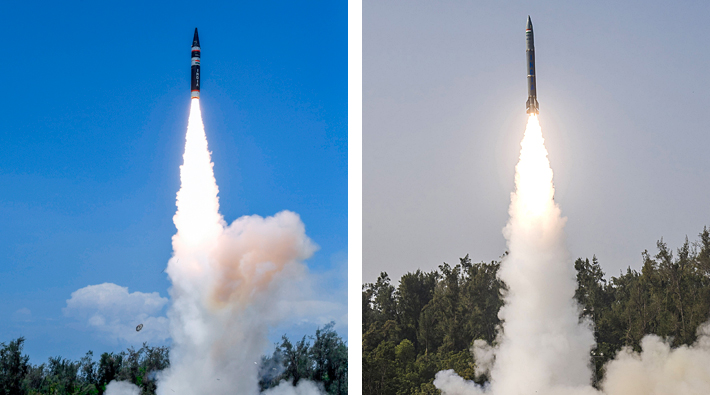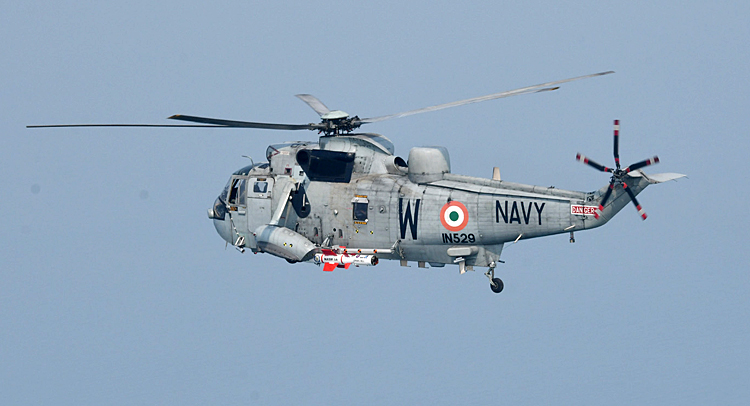INDIAN ARMED FORCES CHIEFS ON OUR RELENTLESS AND FOCUSED PUBLISHING EFFORTS

The insightful articles, inspiring narrations and analytical perspectives presented by the Editorial Team, establish an alluring connect with the reader. My compliments and best wishes to SP Guide Publications.

"Over the past 60 years, the growth of SP Guide Publications has mirrored the rising stature of Indian Navy. Its well-researched and informative magazines on Defence and Aerospace sector have served to shape an educated opinion of our military personnel, policy makers and the public alike. I wish SP's Publication team continued success, fair winds and following seas in all future endeavour!"

Since, its inception in 1964, SP Guide Publications has consistently demonstrated commitment to high-quality journalism in the aerospace and defence sectors, earning a well-deserved reputation as Asia's largest media house in this domain. I wish SP Guide Publications continued success in its pursuit of excellence.
Indigenous Hypersonic Missile
The HGV can perform terminal manoeuvres and follow highly complex and adaptive flight paths. With a demonstrated range of at least 1,500 km, the missile will have several warhead configurations for use in various roles.
 |
The Author is Former Director General of Information Systems and A Special Forces Veteran, Indian Army |

The Defence Research and Development Organisation (DRDO) has developed a number of missiles for the Indian Armed Forces; like the K Missile, Prithvi, Agni, Pralay, Prahaar and Shaurya. The Pralay and Prahaar missiles carry conventional warheads with a range of up to 150–500 km and are intended for supporting the tactical battlefield. The rest of the missiles carry nuclear warheads. Therefore, the development of a conventionally armed missile with a range of more than 1,500 km was considered necessary in order to counter ship-based threats in the Indian Ocean, as well as land-based threats from beyond the Line of Actual Control (LAC) deeper inside China. To acquire such a capability, the DRDO had completed the design work of a land-based 1,500 km range missile, as well as an anti-ship variant by September 2023.
The Year End Review of the Ministry of Defence (MoD) in 2023 first mentioned the under-development missile, designated as the Long-Range Anti-Ship Missile (LRAShM). Another missile, designated as BM-04 was developed in 2024 and its model displayed in March 2025; a variant of Agni-P ballistic missile for neutralizing enemy anti-access/area denial (A2/AD) capabilities and ensure that the India's defence forces do not face any operational restrictions in a highly contested battlefield. The BM-04 was developed as a response to the requirement of the Indian Armed Forces to equip the proposed Integrated Rocket Force with a 1,500 km range-class conventional ballistic missile.
The LRAShM was again successfully tested on November 16, 2024, where it was tracked by optical sensors and its terminal manoeuvres and accuracy met the development team's expectations
The first test of the LRAShM was conducted in 2023. The missile was again successfully tested on November 16, 2024 from the Abdul Kalam Island in Odisha, where it was tracked by optical sensors and its terminal manoeuvres and accuracy met the development team's expectations. The missile features a delta-wing hypersonic glide vehicle (HGV) mounted on a missile booster which sends it partially into orbit. The HGV can perform terminal manoeuvres and follow highly complex and adaptive flight paths. With a demonstrated range of at least 1,500 km, the missile will have several warhead configurations for use in various roles. LRAShM is cold-launched from a hermetically sealed container. Before the first-stage solid rocket motor ignites, it fires control thrusters twice. Beginning around eight seconds after lift-off, the missile's trajectory shifts from vertical to horizontal in about six seconds. A booster stage and a hypersonic sustainer engine make up the two solid propellent rocket stages of the LRAShM. The mid-body of the rocket has cruciform, short span, and long chord aerodynamic surfaces, while the aft body has four small triangular fins. Fins give flight stability, whereas mid-body aerodynamic surfaces give lift, flight path control, and manoeuvrability. The cruciform design lowers aerodynamic drag at high speed.
According to the reports of March 7, 2025, the LRAShM hypersonic glide vehicle can travel at the incredible speed of 12,144 km/h and can destroy a warship within seven to eight minutes of being launched
Hypersonic glide vehicles travel at a lower speed and altitude during the terminal phase as compared to traditional ballistic missiles, making them potentially vulnerable to sophisticated terminal phase interceptors if defensive assets are properly positioned. However, the midcourse phase flight profile of a hypersonic glide vehicle is flatter than that of a ballistic missile, which makes it possible to manoeuvre beneath or around missile defence radar scanning arcs.

According to the reports of March 7, 2025, the LRAShM hypersonic glide vehicle can travel at the incredible speed of 12,144 km/h. Terming it the modern-day Brahmastra, the report says it can destroy a warship within seven to eight minutes of being launched. The report further says that the LRAShM operates at a speed of 10 Mach, making it 10 times faster than the speed of sound, meaning it can cover a distance of 3.37 km in a second. With the successful test of LRAShM, the Indian Navy aims to gain a consequential strategic advantage in the Indian Ocean Region (IOR).
A significant development is China's new Large Phased Array Radar (LPAR), located in Yunnan Province (close to its border with Myanmar), extending surveillance capabilities over India, especially its missile tests
Concurrent to the above, a significant development is China's new Large Phased Array Radar (LPAR), located in Yunnan Province (close to its border with Myanmar), extending surveillance capabilities over India, especially its missile tests. With a range of over 5,000 km, this giant anti-hypersonic advanced radar system offers China real-time tracking of ballistic missile launches. The radar's strategic location enhances China's surveillance over key maritime zones, intensifying regional military tensions.

Unlike conventional radars that rely on mechanical rotation, LPARs use electronically controlled antennas that scan vast areas almost instantly. This allows them to track multiple objects with precision, making them a crucial component of modern air defence networks. All ballistic missiles, including those armed with nuclear warheads, travel through low-earth orbit before re-entering the atmosphere. Advanced radar systems like LPAR are specifically designed to track these trajectories.
The placement of this new Chinese radar that gives Beijing an unprecedented intelligence advantage, allowing the PLA to detect, track, and analyse every missile test India conducts
The Abdul Kalam Island (India's missile testing site) in Odisha is approximately 2,000–2,200 km southwest of China's new radar station; well within LPAR's detection range, allowing Beijing to pick up signals of all missile launches. China has already deployed similar radars in Korla and Xinjiang, which monitor northern India. The addition of the Yunnan-based radar extends China's surveillance reach to the Indian Ocean and Bay of Bengal. This radar is reportedly under 'Base 37', a specialised unit of the People's Liberation Army Aerospace Force (PLAAF) responsible for monitoring foreign space objects and providing early missile warning. Base 37 is also a hub for space situational awareness (SSA), processing vast amounts of orbital data.
Indian security concerns include the placement of this new Chinese radar that gives Beijing an unprecedented intelligence advantage; allowing the PLA to detect, track, and analyse every missile test India conducts, giving it insights into our strategic capabilities.





